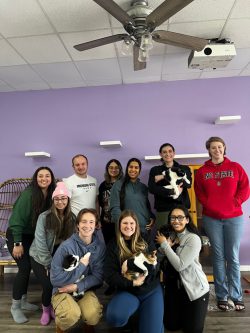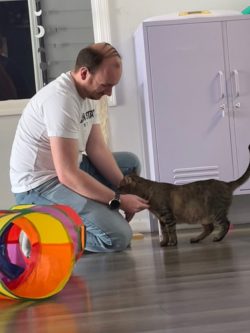How do future feline vets unwind? With more cats!

A group of students attended a movie watch party at Constellation Cat Café in East Lansing to hang out with cats and see the Oscar-winning animated movie “Flow.” Alongside a light April drizzle outside, it was raining cats and kittens.
The event was organized by the MSU Student Chapter of the American Association of Feline Practitioners (SCAAFP)—a student organization at the College of Veterinary Medicine that provides guest lectures, resources, and activities that prioritize feline-specific medicine and handling techniques.
“Cats are significantly less likely to visit the veterinarian than their canine counterparts, often due to stress of travel and handling, as well as the misconception that they require less medical attention. Our club aims to help bridge that gap by promoting feline-focused education, empowering future veterinarians to feel confident and competent in treating their feline patients,” explains Claudia Gabel, DVM class of 2027 and SCAAFP vice president.

Even when taking a break from studying cats, it’s nice to have them around for therapeutic pets and purrs.
“It can be challenging to prioritize our wellness amidst a demanding curriculum,” says Elyan Forbis, DVM class of 2028 and SCAAFP wet lab coordinator. “But mental and physical well-being are crucial for us to perform our best. It’s so important to create spaces for students to recharge, whether it’s through relaxing social events, skill-building labs, or simply time spent with animals. Taking care of ourselves enables us to be better equipped to take care of our future patients.”
PURRactice makes PURRfect

Not only did the cat-themed movie event allow members time to unwind, but it also provided an opportunity to practice their physical exam skills—like feeling for a cat’s pulse or checking skin condition—on friendly feline patients.
“Practicing clinical skills, like general physical exams, in a casual and low-pressure environment helps us build confidence and competence before we’re in the clinic with real patients,” explains Forbis. “These opportunities allow us to focus on perfecting our technique, developing a good flow, and getting comfortable adapting to different cats and situations.”
Wet Lab Collabs
The club also organizes wet labs (hands-on labs to help gain veterinary experience) oriented to practicing skills and often serving the local community. Recently they held a spay and neuter event at Capital Area Humane Society in collaboration with the MSU Student Chapter of the Association of Shelter Veterinarians. This allowed students to get spay and neuter practice while also assisting the shelter with the large volume of spays and neuters that must be completed on a regular basis.
With the assistance of Dr. Karen Perry, Pat Carrigan professor of feline medicine at the College, the club also hosted a wet lab focused on feline orthopedic exams, and many more.
From practice passing urinary catheters, hematology study, and brushing up on Spanish for use in the clinic with the Student Chapter of the Latin American Veterinary Association, student clubs, in collaboration with each other, offer valuable opportunities to work on their skills and exercise their classroom knowledge to flesh out their curricular learning.
It’s part study group, part event organizing body, part social club, and 100 percent passion for feline medicine.
“The Feline Club isn’t just about building clinical skills—it's also about building a sense of community and connection,” emphasizes Forbis. “We are so grateful for the support we get from other clubs and faculty who make these events possible. Veterinary school can feel isolating at times, but being part of a club like this creates an environment where students can bond over shared interests and support each other.”
